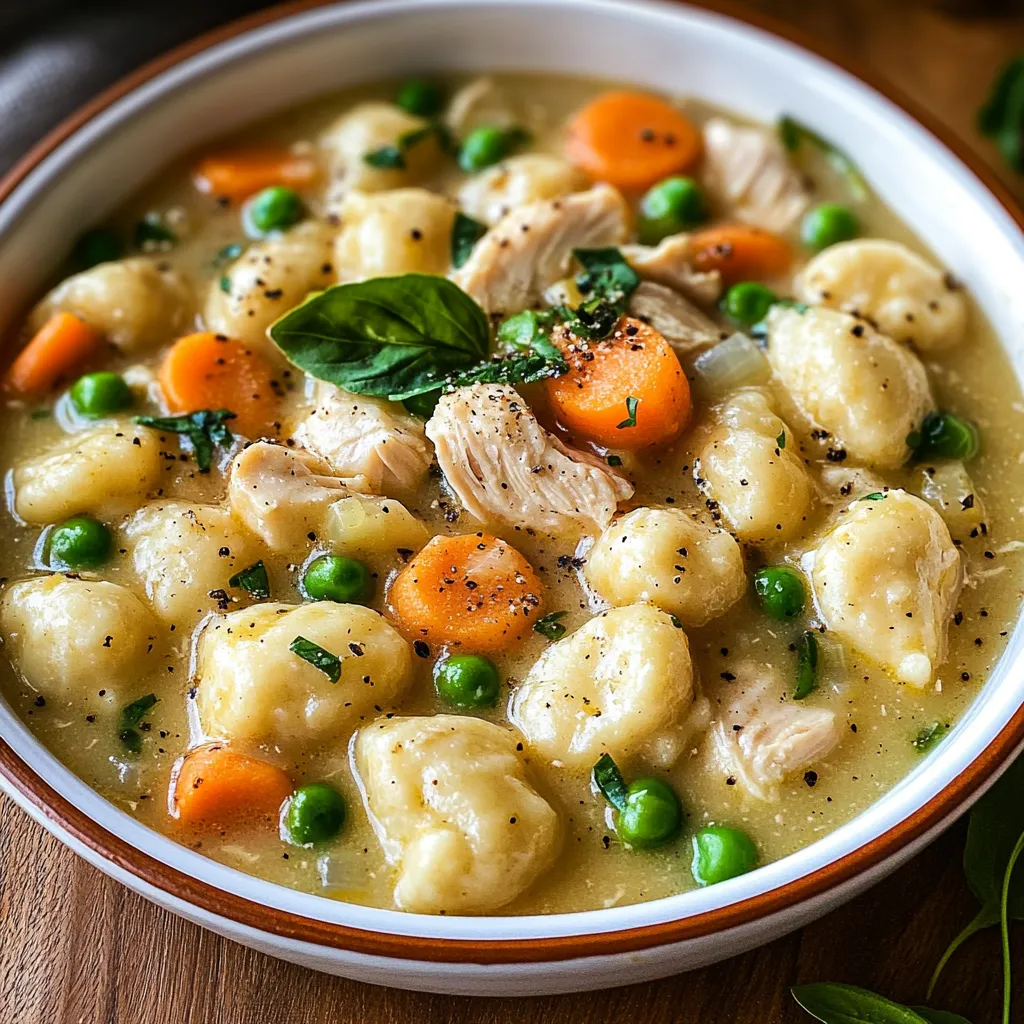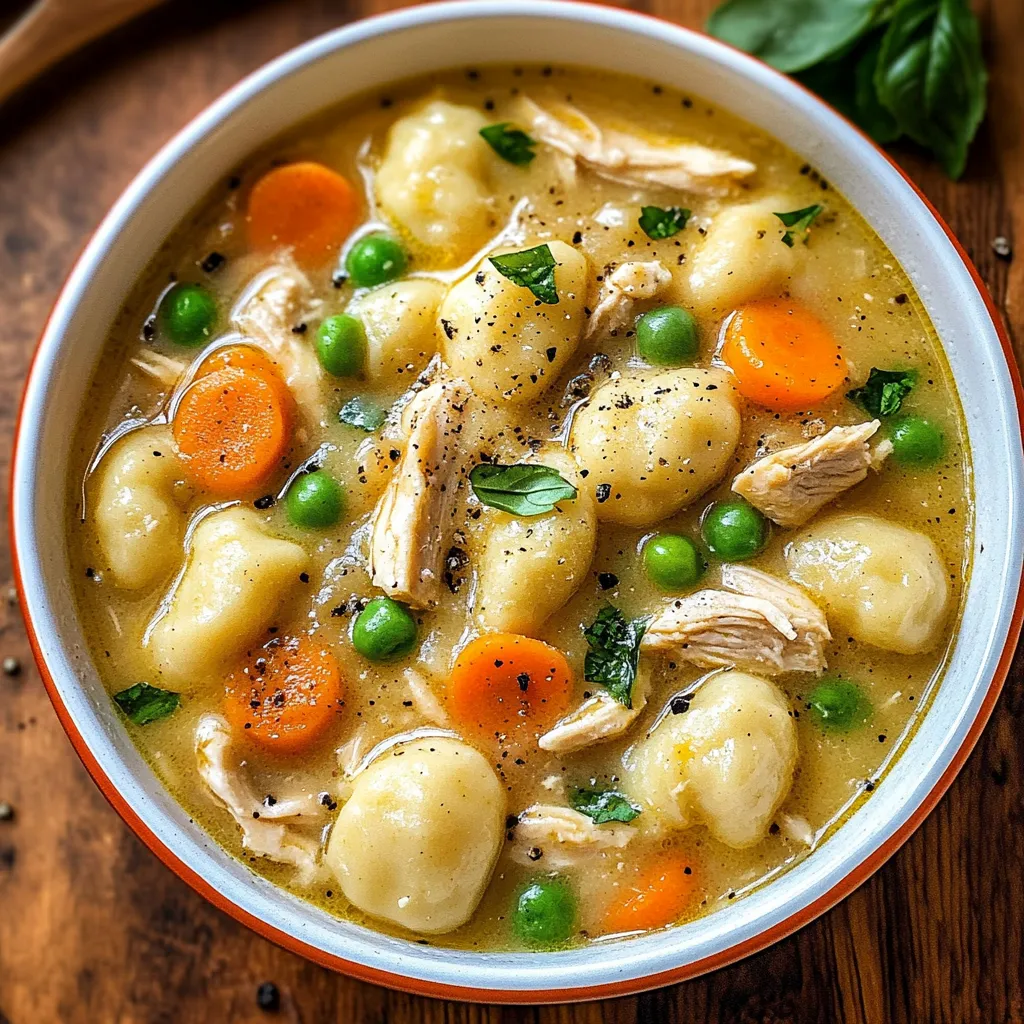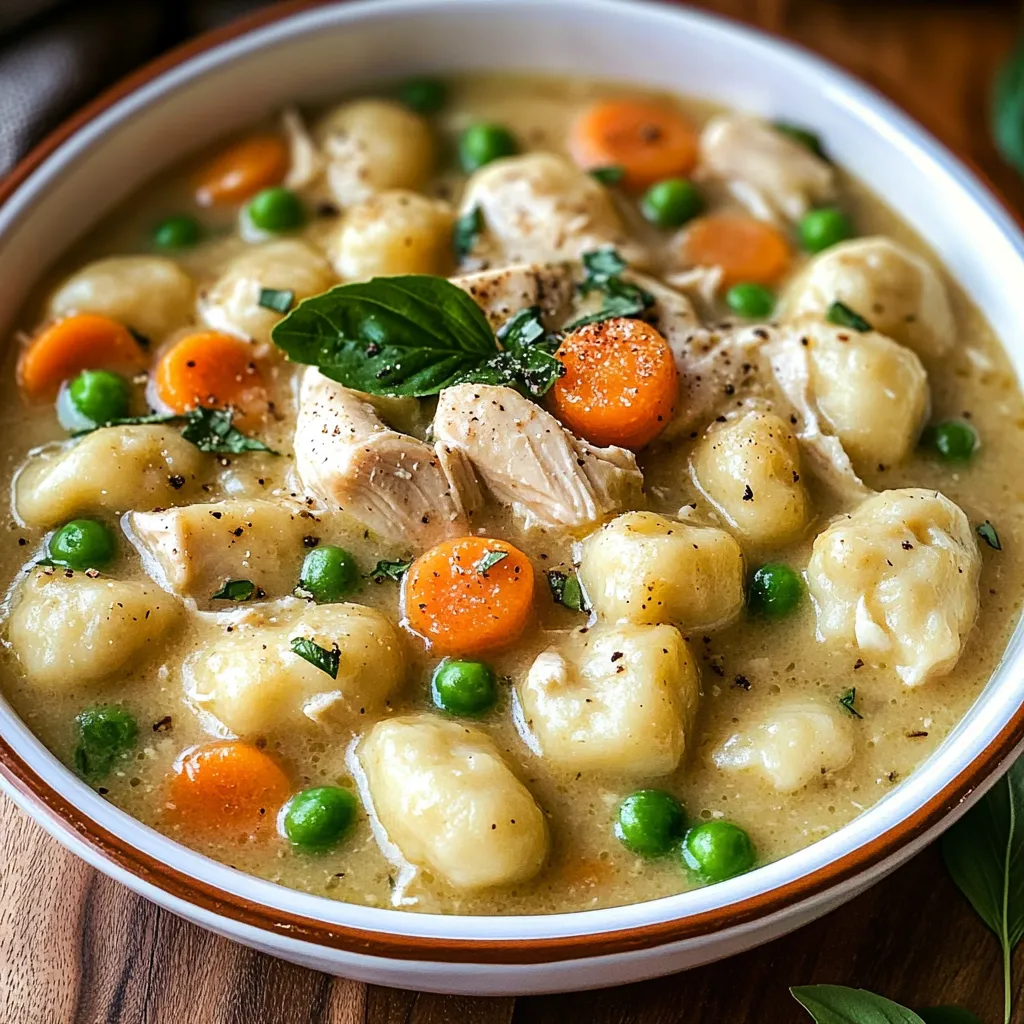 Save
Save
Pillowy potato dumplings nestle alongside tender chicken and vibrant vegetables in a velvety herb-infused sauce that transforms two comfort classics into one extraordinary creation. This One Pot Gnocchi Chicken Pot Pie brilliantly reimagines traditional recipes through inspired fusion and technical simplification. Each spoonful delivers the nostalgic essence of chicken pot pie with the comforting texture of dumplings—creating a dish that satisfies both the palate and the soul while requiring remarkably little effort or cleanup.
I discovered this inspired combination during a particularly challenging winter evening when my family craved the warmth of chicken pot pie but I lacked both time and energy for traditional pastry preparation. The first time I served this improvised creation, my husband—typically sparing with culinary compliments—looked up from his bowl with genuine wonder and asked, 'How did you make something this comforting in so little time?' My young daughter, ordinarily skeptical of new dishes, requested seconds and asked if we could have it again tomorrow. What began as practical necessity has evolved into our most-requested family comfort meal, proving that sometimes the most memorable culinary innovations emerge from imposed limitations rather than endless possibility.
Comforting Components
- Butter: European-style contains higher butterfat for superior flavor; unsalted allows seasoning control
- Carrots: Sweet organic varieties offer optimal flavor; uniform dice ensures even cooking
- Celery: Inner stalks provide tender texture; including some leaves adds aromatic complexity
- Mushrooms: Cremini varieties contribute earthy depth; proper browning develops umami richness
- Shallot: Provides delicate aromatics; minced finely distributes flavor more effectively than onion
- Garlic: Fresh cloves deliver aromatic foundation; proper mincing ensures even distribution
- All-purpose flour: Creates silken thickening foundation; gluten-free blends substitute beautifully
- Chicken stock: Homemade provides superior flavor; high-quality store-bought creates convenience
- Milk: Whole varieties create ideal richness; plant-based alternatives work remarkably well
- Gnocchi: Shelf-stable varieties offer convenience; refrigerated provides superior texture
- Chicken: Rotisserie provides practical flavor foundation; home-roasted offers personalized seasoning
- Frozen peas: Sweet varieties maintain vibrant color; adding while frozen prevents overcooking
- Poultry seasoning: Provides complex herbal notes; homemade blends allow customization
- Fresh thyme: Offers bright aromatic dimension; woody stems removed before serving
Culinary Creation
- Aromatic Foundation
- Begin by melting butter in a generously sized Dutch oven or heavy-bottomed pot over medium heat until it shimmers invitingly but doesn't brown. Add precisely diced carrots, celery, and mushrooms, along with minced shallot, sautéing gently until vegetables begin releasing their moisture and developing translucency. This patient process builds essential flavor complexity that will permeate the entire dish. The vegetables should soften while maintaining structural integrity, creating distinct textural elements rather than homogeneous mush. Add minced garlic during the final minute, allowing its aromatic compounds to bloom without risking bitterness from excessive heat.
- Velvety Transformation
- Sprinkle flour evenly across the sautéed vegetables, stirring constantly for approximately two minutes to cook away any raw taste while creating a roux that will ultimately thicken your sauce to silken perfection. This critical step requires attention to prevent burning while ensuring the flour particles become fully coated with fat. Gradually introduce warm chicken stock and milk in a slow, steady stream while whisking continuously to prevent lumps from forming. This methodical incorporation creates the smoothest possible sauce texture. Allow the mixture to simmer gently until it begins thickening slightly, approximately 3-4 minutes, as it will continue developing body throughout the cooking process.
- Textural Integration
- Once your sauce has begun to thicken, add uncooked gnocchi directly to the simmering liquid, stirring gently to ensure each dumpling receives even heat exposure. This one-pot approach allows the gnocchi to cook while simultaneously releasing starches that further enrich the sauce—a brilliant symbiotic relationship that creates extraordinary texture with minimal effort. The gnocchi will gradually transform from dense to pillowy as they absorb the flavorful liquid, signaling their readiness when they float to the surface, typically within 3-4 minutes depending on variety and size.
- Protein Enhancement
- Incorporate shredded or diced cooked chicken along with frozen peas once the gnocchi have nearly finished cooking. This thoughtful timing prevents the chicken from becoming stringy through overcooking while allowing the peas to heat through without losing their vibrant color and delicate sweetness. The chicken will gently warm in the residual heat while contributing its own savory essence to the sauce. This layered approach to ingredient addition ensures each component maintains its optimal texture and flavor contribution to the finished dish.
- Harmonic Seasoning
- Introduce dried poultry seasoning, fresh thyme leaves, salt, and freshly ground pepper, adjusting quantities to taste. This final seasoning step allows you to calibrate flavors with precision, accounting for variations in stock salinity and personal preference. Allow the mixture to simmer for one additional minute, permitting the herbs to fully infuse the sauce while the overall consistency reaches ideal creaminess. The finished texture should coat the back of a spoon while maintaining enough fluidity to create the perfect sauce-to-ingredient ratio in each serving.
 Save
Save
My neighbor initially expressed skepticism when I described a one-pot approach to chicken pot pie flavors. The first time she tasted it, her eyes widened in surprise as she declared, 'This is even better than traditional pot pie—and so much easier!' Her reaction confirmed what I'd discovered through experimentation—that sometimes culinary shortcuts not only save time but actually improve the eating experience. The absence of pastry allows the creamy, savory filling to take center stage, while the gnocchi provide the comforting dumpling-like texture that makes each bite supremely satisfying.
Creative Variations
Transform this adaptable dish to accommodate various preferences while maintaining its essential character. For a more pronounced Italian twist, incorporate a handful of sun-dried tomatoes and substitute Italian seasoning for the poultry blend. Create an elegant seafood variation by replacing chicken with tender shrimp or scallops, perhaps adding a splash of white wine to the sauce. For verdant freshness, incorporate baby spinach during the final moments of cooking. Those seeking deeper flavor might add a teaspoon of Dijon mustard or a splash of sherry. For special dietary needs, gluten-free gnocchi and flour perform beautifully, while plant-based milk and butter create a convincing dairy-free version without sacrificing creaminess.
Serving Suggestions
This satisfying dish stands confidently on its own but welcomes thoughtful accompaniments that enhance its comfort-forward character. Serve alongside a simple arugula salad dressed with lemon vinaigrette, providing refreshing counterpoint to the rich, creamy texture. For casual gatherings, offer crusty artisan bread for capturing every drop of the magnificent sauce. A crisp white wine like Pinot Grigio or unoaked Chardonnay provides complementary acidity that balances the dish's richness. For presentation, consider serving in shallow bowls that showcase the beautiful ingredients while containing the generous sauce, finishing with a light sprinkle of fresh herbs for vibrant color contrast.
Practical Preservation
This exceptional dish maintains its quality remarkably well through proper storage techniques. Allow leftovers to cool completely before transferring to airtight containers, refrigerating for up to three days. The flavors often continue developing overnight, creating an even more harmonious blend by the second day. Reheat gently on the stovetop over medium-low heat, adding a splash of milk or stock if the sauce has thickened excessively during storage. Avoid microwave reheating when possible, as it may create uneven hot spots that compromise the gnocchi's texture. If planning to freeze portions, slightly undercook the gnocchi initially, as they will soften further during reheating.
 Save
Save
The first time I created this One Pot Gnocchi Chicken Pot Pie, I was simply seeking an efficient solution to dinner preparation on a demanding weeknight. What I discovered was a dish that delivers more satisfaction with less effort than many of my more complex recipes. Each time I make it, I'm reminded that cooking at its best is about resourcefulness—how thoughtful combinations can elevate simple ingredients, how technical shortcuts can sometimes improve outcomes, and how adapting culinary traditions rather than being bound by them often leads to the most meaningful kitchen magic of all.
Common Questions About Cooking
- → Can I use shelf-stable gnocchi instead of fresh?
- Yes! Shelf-stable gnocchi works perfectly in this recipe. You might need to cook it a minute or two longer than fresh gnocchi.
- → How can I make this gluten-free?
- Use gluten-free flour for the roux and gluten-free gnocchi. Many stores now carry potato gnocchi that's naturally gluten-free.
- → Can I freeze the leftovers?
- Yes, but the texture of the gnocchi may change slightly. Freeze in portions and thaw overnight in the fridge before reheating with a splash of broth.
- → What can I use instead of chicken?
- Turkey works great as a substitute. For a vegetarian version, try adding white beans or extra mushrooms instead of the chicken.
- → Can I add other vegetables?
- Absolutely! Try adding corn, green beans, or bell peppers. Just adjust the cooking time as needed for harder vegetables.
